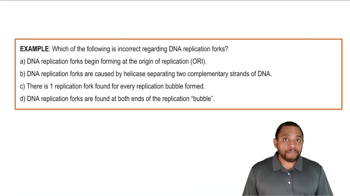Here are the essential concepts you must grasp in order to answer the question correctly.
Plasmid Structure
Plasmids are small, circular, double-stranded DNA molecules found in bacteria and some eukaryotes. They are distinct from chromosomal DNA and can replicate independently within a cell. Their structure typically includes an origin of replication, which allows for autonomous replication, and may also contain genes that confer advantageous traits, such as antibiotic resistance.
Recommended video:
Structural Formula Concept 2
Origin of Replication
The origin of replication (ori) is a specific sequence in a plasmid where DNA replication begins. This region is crucial for the plasmid's ability to replicate independently of the host's chromosomal DNA. The presence of a functional ori allows plasmids to be maintained in a cell during cell division, ensuring that they are passed on to daughter cells.
Recommended video:
Intro to DNA Replication Example 2
Selectable Markers
Selectable markers are genes included in plasmids that provide a way to identify and select for cells that have successfully taken up the plasmid. Common examples include antibiotic resistance genes, which allow only those cells that have incorporated the plasmid to survive in the presence of the antibiotic. This feature is essential in molecular biology for cloning and genetic engineering applications.
Recommended video:
 Verified Solution
Verified Solution



 1:55m
1:55m
